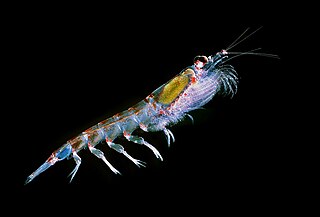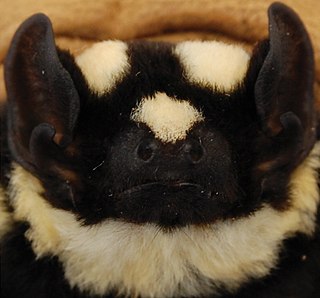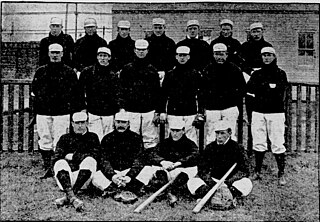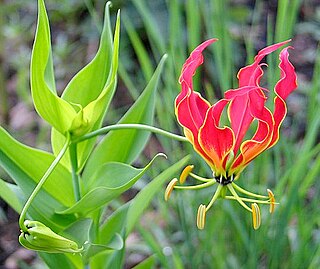Related Research Articles

Antarctic krill is a species of krill found in the Antarctic waters of the Southern Ocean. It is a small, swimming crustacean that lives in large schools, called swarms, sometimes reaching densities of 10,000–30,000 individual animals per cubic metre. It feeds directly on minute phytoplankton, thereby using the primary production energy that the phytoplankton originally derived from the sun in order to sustain their pelagic life cycle. It grows to a length of 6 centimetres (2.4 in), weighs up to 2 grams (0.071 oz), and can live for up to six years. It is a key species in the Antarctic ecosystem and in terms of biomass, is one of the most abundant animal species on the planet – approximately 500 million metric tons.

The greater lophorina, also known as superb bird-of-paradise or greater superb bird-of-paradise, is a species of the Paradisaeidae (bird-of-paradise) family. It was considered the sole species in the genus until in 2017 it was recognised that there were three species.

The Chronicle-Telegraph Cup was the trophy awarded to the winner of a postseason competition in American professional baseball in 1900. The series, played only once, was a precursor to the current World Series.

The hybrid elm cultivar Ulmus × hollandica 'Superba' is one of a number of intermediate forms arising from the crossing of the Wych Elm U. glabra with a variety of Field Elm U. minor. Boulger tentatively (1881) and Green more confidently (1964) equated it with a hybrid elm cultivated in the UK by Masters at Canterbury in the early 19th century, known as "Masters' Canterbury Seedling" or simply the Canterbury Elm. Loudon examined a specimen sent by Masters and considered it a hybrid, calling it U. montana glabra major.

The pied butterfly bat, also known as the pied bat or badger bat, is a rare species of vesper bat in the family Vespertilionidae.
The 1910 Brooklyn Superbas hired Bill Dahlen as the new manager, but still finished in a dismal sixth place in the National League.
The 1909 Brooklyn Superbas handed the manager's job over to outfielder Harry Lumley. However, the team finished in sixth place again and Lumley's playing stats took a tumble as he tried to do both jobs. He was replaced as manager after the season and traded as a player halfway through the next season.
The 1908 Brooklyn Superbas suffered through another poor season, finishing in seventh place. After the season, manager Patsy Donovan was fired. The club set a Major League record which still stands, for the fewest doubles by a team in a season, with only 110. The Superbas hit only .213 as a team, second lowest in the modern era after the 1910 Chicago White Sox. No regulars hit .250, Tim Jordan led the team with a .247 batting average.
The 1907 Brooklyn Superbas finished in fifth place, with another losing season.
The 1906 Brooklyn Superbas saw Patsy Donovan take over as the team's manager. However, another poor season led to a fifth-place finish.
The 1905 Brooklyn Superbas fell to last place with a franchise-worst 48–104 record, costing manager Ned Hanlon his job.
The 1904 Brooklyn Superbas finished in sixth place with a 65–97 record.
The 1903 Brooklyn Superbas season was a season in Major League Baseball. The Superbas began their slide from contention in the National League by finishing in fifth place.

The 1901 Brooklyn Superbas lost several players to the newly official major league, the American League, and fell to third place.
The 1900 Brooklyn Superbas captured their second consecutive National League championship by four and a half games. The Baltimore Orioles, which had been owned by the same group, folded after the 1899 season when such arrangements were outlawed, and a number of the Orioles' players, including star pitcher Joe McGinnity, were reassigned to the Superbas.
The 1899 Brooklyn Superbas season was the 16th season of the current-day Dodgers franchise and the ninth season in the National League. The team won the National League pennant with a record of 101–47, 8 games ahead of the Boston Beaneaters, after finishing tenth in 1898.
The elm cultivar Ulmus × hollandica 'Blandford' was listed by the Urban Forestry Administration (UFA) of the District Department of Transportation in Washington, D.C., as one of its 'street trees' in 2008. As the UFA has no further documentation to support it, the entry may be spurious, but it is most likely the tree is the wych elm cultivar Ulmus glabra 'Superba', known in the UK as the 'Blandford Elm' and introduced to the US in the early 20th century, or possibly the hybrid cultivar Ulmus × hollandica 'Superba' present in some American collections, including Garfield Park, Washington, D.C., in the mid-20th century.

Gloriosa superba is a species of flowering plant in the family Colchicaceae. Common names include flame lily, climbing lily, creeping lily, glory lily, gloriosa lily, tiger claw, the Poison Plant, agnishikha and fire lily.
Taurolema is a genus of longhorn beetles of the subfamily Lamiinae, containing the following species:

The wych elm cultivar Ulmus glabraHuds. 'Superba', Blandford Elm, with unusually large leaves, was raised by Gill's of Blandford Forum, Dorset, in the early 1840s as Ulmus montana superba and was quickly distributed to other UK nurseries. It was confirmed as a form of wych, and first described by Lindley in The Gardeners' Chronicle, 1845, later descriptions being added by Gill (1845) and Morren (1848), who called it U. montana var. superba. Morren had adopted the name 'Superba' from the Fulham nurseryman Osborne in 1844, who supplied him with the tree – presumably one of the nurseries supplied by Gill. Morren states that 'Superba', already in cultivation in England, was introduced to Belgium by Denis Henrard of Saint Walburge, Liège, that in 1848 it had been present in Belgium for only three years, and that this variety was the one described as 'Superba' by Osborne, whom Henrard had visited at his nursery in Fulham in September 1844. 'Blandford Elm', with leaves of the same dimensions, was soon for sale in the USA.
References
- ↑ BioLib.cz - Taurolema superba Archived 2018-09-11 at the Wayback Machine . Retrieved 8 September 2014.